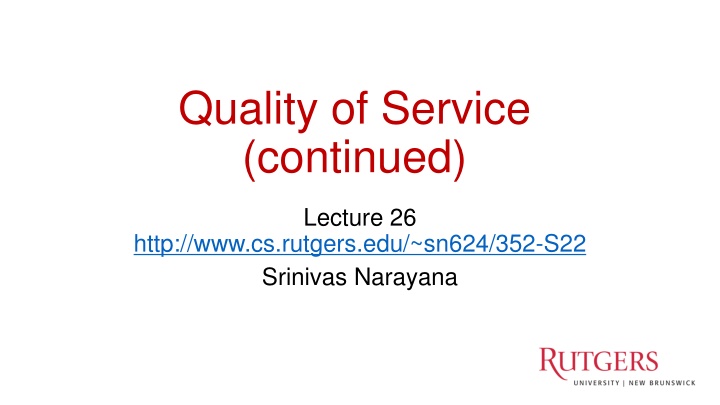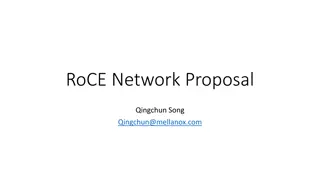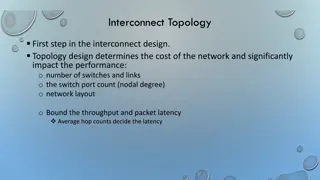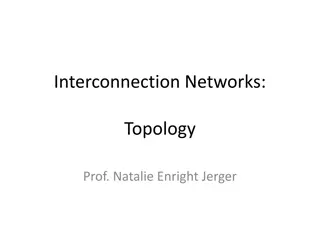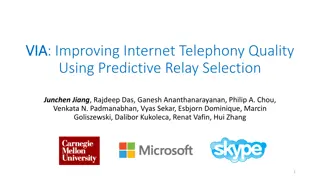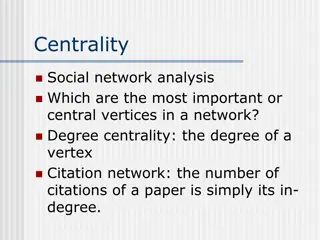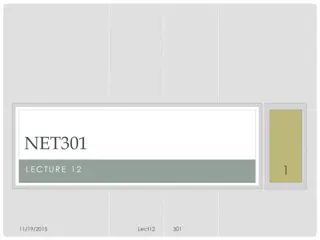Enhancing Network Performance Through Quality of Service Measures
Delve into the critical aspects of Quality of Service (QoS) in computer networks to ensure efficient data transmission. Explore the significance of service guarantees, rate limiting, transmission rate measurements, and rate enforcement policies using shaping and policing mechanisms like leaky buckets and token buckets. Understand the implications of scheduling on network neutrality debates and the need for differentiated classes of traffic for optimal network performance.
Uploaded on Oct 08, 2024 | 2 Views
Download Presentation

Please find below an Image/Link to download the presentation.
The content on the website is provided AS IS for your information and personal use only. It may not be sold, licensed, or shared on other websites without obtaining consent from the author.If you encounter any issues during the download, it is possible that the publisher has removed the file from their server.
You are allowed to download the files provided on this website for personal or commercial use, subject to the condition that they are used lawfully. All files are the property of their respective owners.
The content on the website is provided AS IS for your information and personal use only. It may not be sold, licensed, or shared on other websites without obtaining consent from the author.
E N D
Presentation Transcript
Quality of Service (continued) Lecture 26 http://www.cs.rutgers.edu/~sn624/352-S22 Srinivas Narayana 1
Best effort networking isnt enough High delay Conf call: Requires low latency Packet drops BitTorrent: Requires high throughput FIFO queue Resource contention occurs in the core of the network Congestion control will react, but may be too little & too late Instead, network should differentiate classes of traffic Network should provide service guarantees for each class Prioritization, rate limiting, fair queueing Implemented in the router s packet scheduler
Why care about service guarantees? Influences how packets are treated at contentious resources in the core of the network Regardless of the endpoint transport Implementations of scheduling (QoS) within large networks have implications for debates on network neutrality Scheduling is a fundamental problem in computer networks Next: Rate limiting
Measures of transmission rate Long-term/average rate: data rate transmitted per unit time, over a long period Crucial question: what is the time interval over which rate is measured? Average and instantaneous behaviors can be very different Same average rate Rate Rate Measurement duration Measurement duration Time Time
Measures of transmission rate Peak rate: largest instantaneous rate that is transmitted Measurement duration is typically very small Burst size: maximum amount of data sent consecutively without any intervening idle periods Measurement duration peak rate Rate Time
Rate enforcement There are two kinds of rate enforcement policies: shaping and policing Two specific mechanisms to implement those: leaky buckets and token buckets Basic mechanism: wait for the passage of appropriate time before releasing packets for transmission
Shaping vs. Policing Enforces rate by queueing excess packets in a buffer Drop only if buffer is full Enforces rate by dropping excess packets immediately Can result in high loss rates Requires memory to buffer packets Does not require a memory buffer Can inflate round-trip time (queueing in shaping buffer) No additional inflation in round-trip times
Intuition: release packets at steady rate Packets from source Bucket leaking water at a steady Leaky Bucket Shaper Shaping buffer rate Timed release mechanism for packets Packets leaving at steady rate
Leaky Bucket Shaper Packets may enter in a bursty manner However, once they pass through the leaky bucket, they are evenly spaced The shaping buffer holds packets up to a certain point If the buffer is full, packets are dropped Setting the rate is a policy concern Assume an admin provides us the rate Shapers may be used in the core of a network to limit bandwidth use, or at the edge to pace packets entering the network in the first place
Leaky Bucket Shaper For a leaky bucket shaper, assume average rate == peak rate However, many Internet transfers just have a few packets For example, web requests and responses Enforcing rate limit for those can significantly delay completion We often wish to have peak rate higher than avg rate Especially at the beginning of a connection If so, use a token bucket: burst-tolerant version of a leaky bucket
Token bucket shaper Fill at rate r Limits traffic class to a specified average rate r and burst size B Tokens are filled in at rate r The token bucket can hold a maximum of B tokens. Further tokens dropped Note: distinct from shaping buffer size Suppose a packet is at the head of the shaping buffer If a token exists in the bucket, remove token, and transmit the packet If not, wait. Bucket size B Packets Remove token Transmit Shaping buffer
Token bucket shaper Fill at rate r In time t, the maximum number of packets that depart the shaper is (r * t) + B A full bucket of tokens would allow small flows to go through unaffected A maximum burst of B packets Longer flows have average rate r Bucket emptied initially, the rest of the flow must respect the token fill rate As t , the average rate approaches r That is, (1/t) * (r*t + B) r Bucket size B Packets Remove token Transmit Shaping buffer
Token bucket policer Fill at rate r A token bucket policer is just a token bucket shaper without the shaping buffer No place for packets to wait if there are no tokens If token exists, packet transmitted. If not, packet dropped Simple and efficient to implement. The internet has tons of token bucket policers Bucket size B Packets Remove token Transmit Shaping buffer
Google study from 2016 Small but non-trivial fraction of policed links Significant impact on packet loss rate Flach et al., An Internet-Wide Analysis of Traffic Policing, SIGCOMM 2016
Impact on TCP Policers drop multiple packets in a burst: causing RTOs and retransmissions after emptying of token bucket Slow start period: burst allowed with a full bucket of tokens
Effect on actual apps: YouTube Video rebuffer rate: rebuffer time / overall watch time
Summary of rate limiting Rate limiting is a useful mechanism to isolate traffic classes from each other Two strategies: policing and shaping Leaky bucket and token bucket The Internet has a lot of token bucket policers, causing real impact on TCP connections and app performance Understand how ISPs treat consumer Internet traffic
Synthesis:a day in the life of a web request Goal: identify, review, understand protocols (at all layers) involved in seemingly simple scenario: requesting www page Scenario: student attaches laptop to campus network, requests/receives www.google.com 23
A day in the life: scenario DNS server browser Comcast network 68.80.0.0/13 school network 68.80.2.0/24 web page web server Google s network 64.233.160.0/19 64.233.169.105 24
A day in the life connecting to the Internet connecting laptop needs to get its own IP address, addr of first- hop router, addr of DNS server: use DHCP DHCP UDP IP Eth Phy DHCP DHCP DHCP DHCP DHCP DHCP request encapsulated in UDP, encapsulated in IP, encapsulated in link layer Ethernet DHCP UDP IP Eth Phy DHCP DHCP DHCP DHCP router (runs DHCP) DHCP Packet broadcast (dest: FFFFFFFFFFFF) on the local network, received at a router running DHCP server Ethernet decapsulated to IP decapsulated to UDP decapsulated to DHCP 25
A day in the life connecting to the Internet DHCP UDP IP Eth Phy DHCP server formulates DHCP ACK containing client s IP address, IP address of first-hop router for client, name & IP address of DNS server DHCP DHCP DHCP DHCP DHCP client receives DHCP ACK reply DHCP UDP IP Eth Phy DHCP DHCP DHCP router (runs DHCP) DHCP DHCP Client now has IP address, knows name & addr of DNS server, IP address of its first-hop router 26
A day in the life ARP (before DNS, before HTTP) before sending HTTPrequest, need IP address of www.google.com: DNS DNS UDP IP Eth Phy DNS DNS DNS ARP ARP query DNS query created, encapsulated in UDP, encapsulated in IP, encapsulated in Eth. To send frame to router, need MAC address of router interface: ARP ARP Eth Phy ARP reply ARP query broadcast, received by router, which replies with ARP reply giving MAC address of router interface router (runs DHCP) client now knows MAC address of gateway router, so can now send packet containing DNS query 27
A day in the life using DNS DNS UDP IP Eth Phy DNS server DNS DNS DNS UDP IP Eth Phy DNS DNS DNS DNS DNS DNS DNS Comcast network 68.80.0.0/13 IP datagram forwarded from campus network into Comcast network, routed (tables created by EIGRP, OSPF, and/or BGP routing protocols) to DNS server router (runs DHCP) IP datagram containing DNS query from client to gateway router decapsulated to DNS server DNS server replies to client with IP address of www.google.com 28
A day in the lifeTCP connection carrying HTTP HTTP HTTP TCP IP Eth Phy SYNACK SYN SYN SYNACK SYNACK SYN SYN to send HTTP request, client first opens TCP socket to web server router (runs DHCP) TCP packet routed using inter-domain routing (BGP) and intra-domain routing (OSPF, EIGRP) to web server TCP IP Eth Phy SYNACK SYN SYN SYNACK SYNACK SYNACK SYN web server 64.233.169.105 29
A day in the life HTTP request/reply web page finally (!!!) displayed HTTP HTTP HTTP TCP IP Eth Phy HTTP HTTP HTTP HTTP HTTP HTTP HTTP HTTP request sent into TCP socket IP datagram containing HTTP request routed to www.google.com web server responds with HTTP reply (containing web page) router (runs DHCP) HTTP TCP IP Eth Phy HTTP HTTP HTTP HTTP HTTP web server IP datagram containing HTTP reply routed back to client 64.233.169.105 30
Outro Computer networks are a stack of layers Built for modularity Each layer does one set of functions very well Each layer depends on the layers beneath it Many general and useful principles Applicable to real life (e.g., feedback control) Applicable to computer system design (e.g., indirection & hierarchy)
Outro: Now what? Go about life as usual One difference: enhanced abilities to work with Internet-based tech Apply your new skills to solve a problem you care about Tons of free and open-source software and platforms. Opportunities Deepen your understanding of the Internet and its tech CS 552 Computer Networks (Fall 2022 - Prof Rich Martin) CS 553 Internet services (Spring 2023 - me) Push the boundaries of Internet tech Talk to me about research
